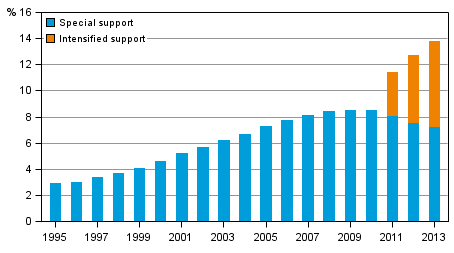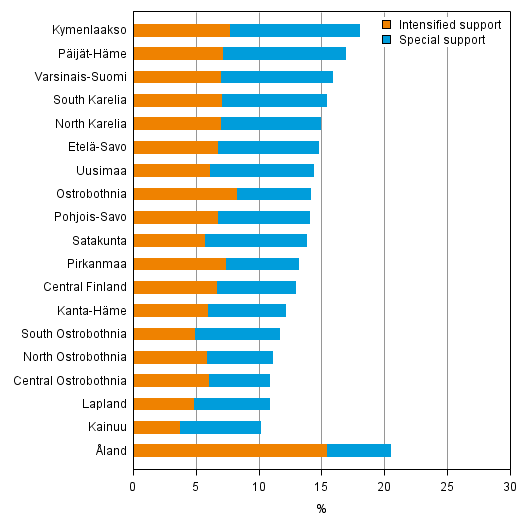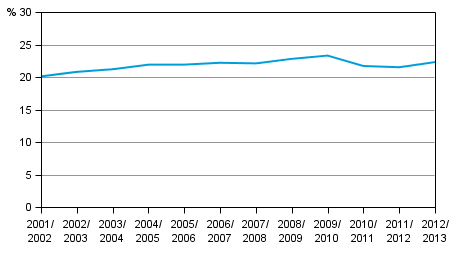Published: 12 June 2014
Share of students having received special support diminished
Since 2011, support to learning for comprehensive school pupils has been divided into general, intensified and special support. If intensified support is not sufficient, special support is provided. After the legislation amendment, the share of pupils having received intensified support has grown yearly. The number of pupils having received special support has gone down every year. These data derive from Statistics Finland’s education statistics.
Share of comprehensive school pupils having received intensified or special support among all comprehensive school pupils 1995–2013, %

1) Pupils accepted or transferred to special education during 1995 to 2010 have been regarded as equal to pupils having received special support.
In autumn 2013, 35,000 comprehensive school pupils received intensified support, which made up 6.5 per cent of all comprehensive school pupils. This is 3.2 percentage points more than in 2011. A total of 39,600 pupils, or 7.3 per cent of all comprehensive school pupils received special support. The share is 0.8 percentage points lower than in 2011. In all, 540,500 pupils were in pre-primary, basic and additional education of the comprehensive school.
In 2013, 65 per cent of the recipients of intensified support were boys and 35 per cent girls. Among the recipients of special support, 70 per cent were boys and 30 per cent girls.
The statistics on special education in comprehensive schools mainly contain data on intensified and special support . Data can be obtained on pupils having received general support by viewing the number of those having received part-time special education.
Data on special education in vocational education are collected at the end of this release and in Appendix table 9 .
Eighteen per cent of pupils received special or intensified support in Kymenlaakso, ten per cent in Kainuu
The share of comprehensive school pupils who received intensified or special support varied from one region to another in 2013. Intensified or special support was received by around 20 per cent of pupils in ┼land. In Mainland Finland regions, the biggest group of recipients of intensified or special support is found in Kymenlaakso, where 18 per cent of pupils received intensified or special support. The share of recipients of intensified or special support was smallest in Kainuu, where ten per cent of pupils received special or intensified support.
Share of comprehensive school pupils having received intensified or special support by region 2013, %

In Mainland Finland, the share of pupils having received intensified support in all pupils varied between four and eight per cent in different regions. The share of pupils having received intensified support was lowest in Kainuu and highest in Ostrobothnia. In ┼land, 15 per cent of comprehensive school pupils received intensified support.
The share of pupils having received special support in all comprehensive school pupils varied between five and ten per cent in Mainland Finland regions. The share of pupils having received special support was lowest in Central Ostrobothnia and highest in Kymenlaakso. In ┼land, the share of pupils receiving special support was five per cent.
Three out of four pupils in intensified support received part-time special education
Seventy-four per cent of the pupils who received intensified support in 2013 received part-time special education, 57 per cent remedial teaching, and 42 per cent special needs assistance and/or interpretation services. Thirty-seven per cent of the pupils who received special support received part-time special education, 34 per cent remedial teaching, and 57 per cent special needs assistance and/or interpretation services. Twenty-seven per cent of the pupils receiving special support had extended duration of compulsory education.
Among the recipients of special support, 19 per cent received all education in a general education group and 42 per cent received all education in a special education group. Among the recipients of special support, 39 per cent received part of the education in a general education group and part in a special education group.
Good 45 per cent of the pupils having received special support in pre-primary, basic and additional education of the comprehensive school studied general education syllabuses in all subjects. Fourteen per cent of the pupils had individualised syllabuses for one subject, 12 per cent for two to three subjects, and 22 per cent for four or more subjects. Five per cent of the pupils receiving special support studied according to functional skill areas. The teaching can be arranged according to functional skill areas if it cannot be arranged by subject syllabuses due to the pupil's severe disability or illness.
One-fifth of comprehensive schools pupils received part-time special education in the academic year 2012 to 2013
Of comprehensive school students in autumn 2012, 22 per cent, or 120,200 students received part-time special education during the 2012 to 2013 academic year. In the previous 2011 to 2012 academic year, there were fewer recipients of part-time special education, when 116,300 pupils (21 per cent) received part-time special education.
Share of comprehensive school pupils having received part-time special education among all comprehensive school pupils in academic years 2001/2002 to 2012/2013, %

In autumn 2012, part-time special education was included in a learning plan for intensified support for 20,400 pupils and a decision for special support for 15,400 pupils. By subtracting we can conclude that around 84,400 of the 120,200 pupils having received part-time special education in the academic year 2012 to 2013 received part-time special education as general support.
In autumn 2012, a learning plan for intensified support had been made for 27,400 pupils and 41,000 pupils had received a decision for special support. The total number of pupils having received part-time special education as general support, intensified support and special support was around 152,800 in the academic year 2012 to 2013, which is 28 per cent of all pupils in comprehensive schools in autumn 2012. The share is exactly the same as in autumn 2011.
Number of vocational education students having received special education has grown at least from 2004 onwards
The number of students in vocational education leading to a qualification having received special education has grown at least from 2004 onwards, when the production of the statistics was started: 12,500 pupils received special education in 2004, 16,500 in 2008 and 21,200 in 2012. The share of all students having received special education in all students in vocational education leading to a qualification was in the same years five, six and eight per cent.
In 2012, there were 132,550 students in vocational education for young people (curriculum-based basic vocational education provided by educational institutions), of whom 15 per cent were special education students. Seventeen per cent of male students and 13 per cent of female students were special education students. In all, 60 per cent of special education students were men.
Most special education students (86%) in vocational education for young people were studying in vocational education institutions. Thirteen per cent of special education students attended special vocational education institutions and around one per cent other educational institutions providing vocational education.
Seventy-nine per cent of special education students in vocational education for young people were studying in the same groups (integrated) with other students.
Source: Education. Statistics Finland
Inquiries: Suvi Vainio 029 551 2915, koulutustilastot@stat.fi
Director in charge: Riitta Harala
Publication in pdf-format (304.0 kB)
- Tables
-
Tables in databases
Pick the data you need into tables, view the data as graphs, or download the data for your use.
Appendix tables
- Appendix table 1. Comprehensive school pupils having received intensified or special support, 2013 (12.6.2014)
- Appendix table 2. Part-time special education, remedial teaching, and special needs assistance and interpretation services received by comprehensive school pupils having received intensified or special support, 2013 1) (12.6.2014)
- Apprendix table 3. Comprehensive school puplis having received intensified support 2011 - 2013 (12.6.2014)
- Apprendix table 4. Comprehensive school pupils having received special support by duration of compulsory education, 2013 (12.6.2014)
- Appendix table 5. Comprehensive school pupils having received special support by place of provision of teaching, 2013 (12.6.2014)
- Appendix table 6. Pupils having received special support on grades 1-9 and during additional education of comprehensive school by subject syllabus, 2013 (12.6.2014)
- Appendix table 7. Comprehensive school pupils having received special support, 1995-2013 1) (12.6.2014)
- Appendix table 8. Comprehensive school pupils having received part-time special education from academic year 2001/2002 to academic year 2012/2013 (12.6.2014)
- Appendix table 9. Students of special vocational education by place of provision of teaching, 2004-2012 (12.6.2014)
Updated 12.6.2014
Official Statistics of Finland (OSF):
Support for learning [e-publication].
ISSN=1799-1617. 2013. Helsinki: Statistics Finland [referred: 20.12.2025].
Access method: http://stat.fi/til/erop/2013/erop_2013_2014-06-12_tie_001_en.html

